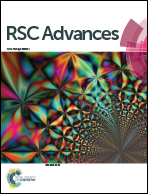All-atom molecular dynamics simulation of HPMA polymers†
Abstract
Structural properties such as size, shape and density distribution of a range of N-(2-hydroxypropyl)methacrylamide (HPMA) polymers in various solvent models have been investigated. Common atomistic force fields were compared against rotational barriers and relative conformational energies obtained from ab initio and density functional theory (DFT) data for a monomer and dimer of HPMA. This identified the AMBER99 parameter set as the most appropriate for representing the structures and so AMBER99 was employed for all molecular dynamics simulations. MD trajectories were calculated for a range of polymer sizes from 4 to 265 repeat units (2 to 35 kDa). The time averaged radius of gyration was extracted from trajectories and interpreted in the context of Flory's mean field approach. Comparison with data obtained from small angle neutron scattering (SANS) experiments was then used to differentiate between alternative solvent models. The shape adopted by such polymers was evaluated by fitting structures to ellipsoids, to allow separate analysis of radius and density profile along each axis. The density distribution of atoms was defined using these ellipsoids according to centre of mass or centre of neutron scattering lengths, the latter allowing direct comparison with experimental SANS data. We show that computational simulation of such polymers has practical application in obtaining detailed morphological information of polymer solution structure, and as a benchmark for coarse-grained methods.


 Please wait while we load your content...
Please wait while we load your content...